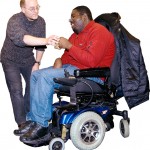
Multi-sensory environments or snoezelen rooms are used in a variety of services supporting people with learning disabilities although there has until recently been a paucity of critical evaluation of their effectiveness. Although there are a number of examples in the literature of a wide range of positive outcomes when Snoezelen and non-Snoezelen environments are contrasted, there has been little evidence of generalisation to the post-Snoezelen environment.
A number of studies also have begun to question the role of supporters in the environment, who may well be affecting positive outcomes irrespective of the sensory effects.
The researchers in this study worked with people with stereotyped behaviours which had been assessed as being maintained by automatic reinforcement , ie, maintained by the reinforcing properties of the behaviour itself. They set out to look at effects on the levels of sterotyped behviours of the sensory equipment provided in the multi-sensory environment and the level of social contact provided.
They looked at what was happening with two young people with severe learning disabilities who engaged in stereotyped behaviours. They observed them when this was happening wither in their usual living room or in the multi -sensory environment. In both settings they carried out observations both when the young people were receiving high and low levels of interaction from their carers.
What they found was that the levels of stereotyped behaviour for both the young people were lower in the multi-sensory environment, whether the levels of attention from the carers were high or low. However, they also found that levels of engagement were higher for both people when levels of carer attention were high, irrespective of the environment.
The authors conclude that their findings provide additional evidence for the view that reductions in stereotyped behaviour found in multi-sensory environments are due to increased levels of specific sensory stimulation provided by such environments, rather than being related to carer attention. This is however, a very small study, and questions about generalisability and longevity of effect remain.
Effects of Multisensory Environments on Stereotyped Behaviours Assessed as Maintained by Automatic Reinforcement, Hill L et al., in Journal of Applied Research in Intellectual Disabilities, 25: 509–521
